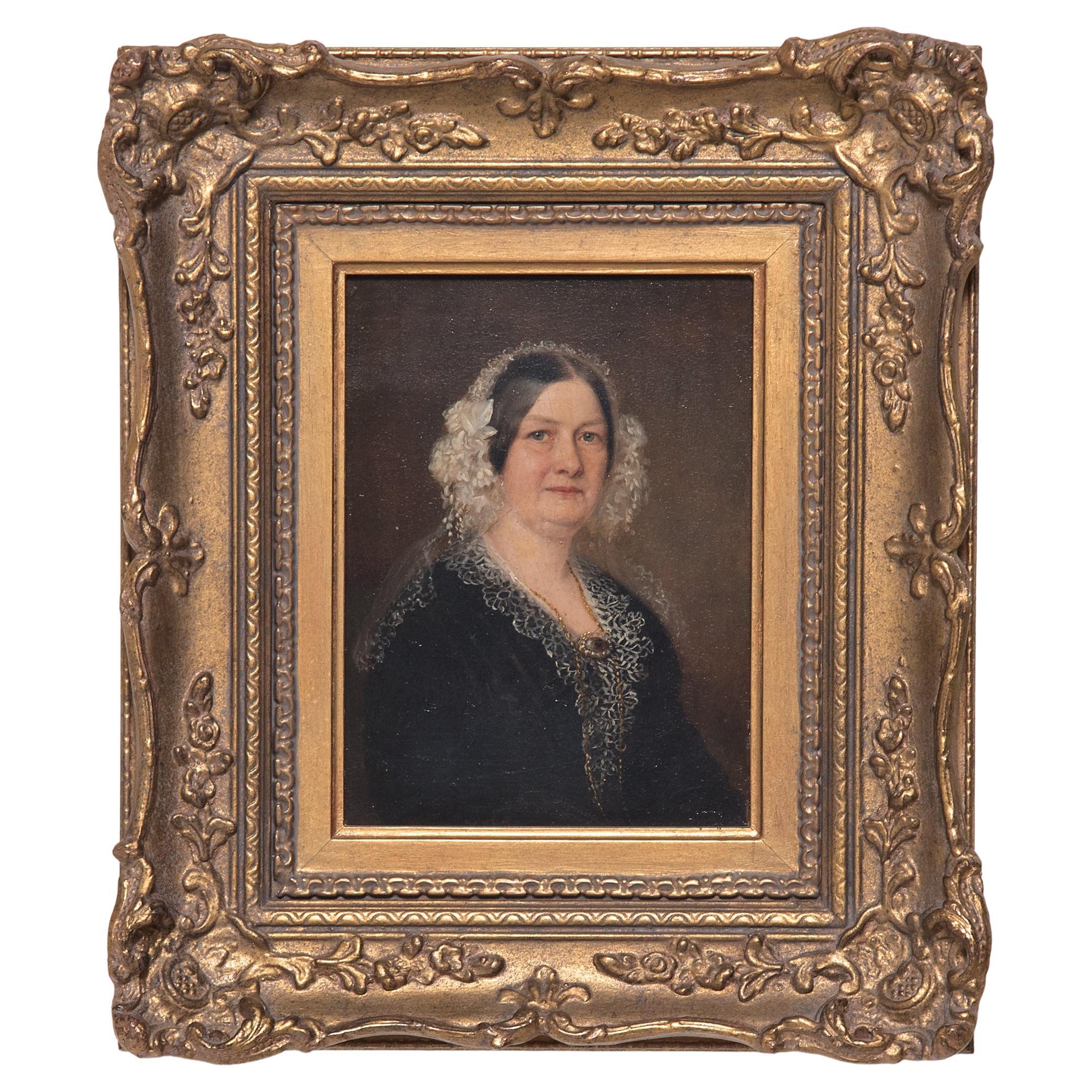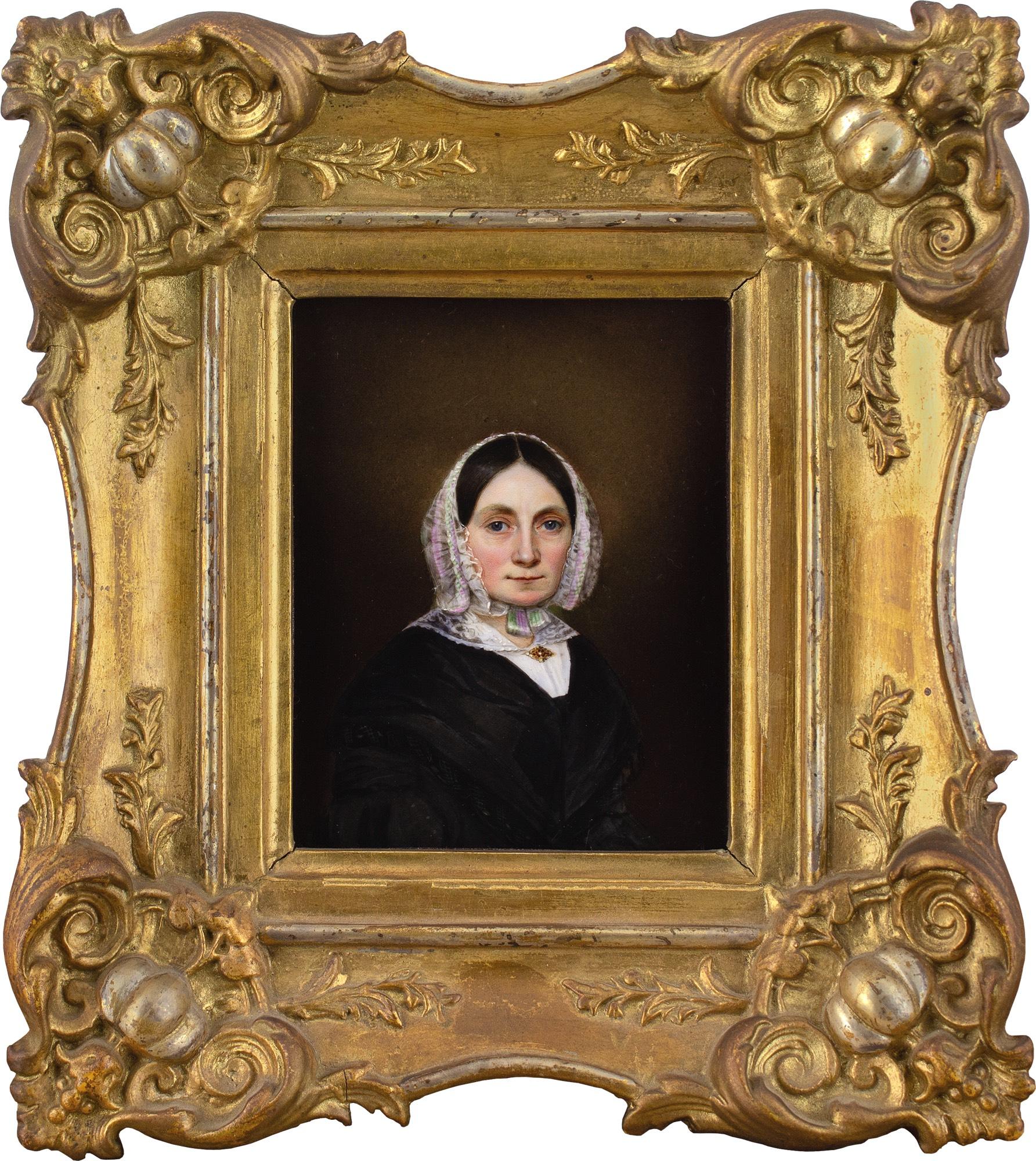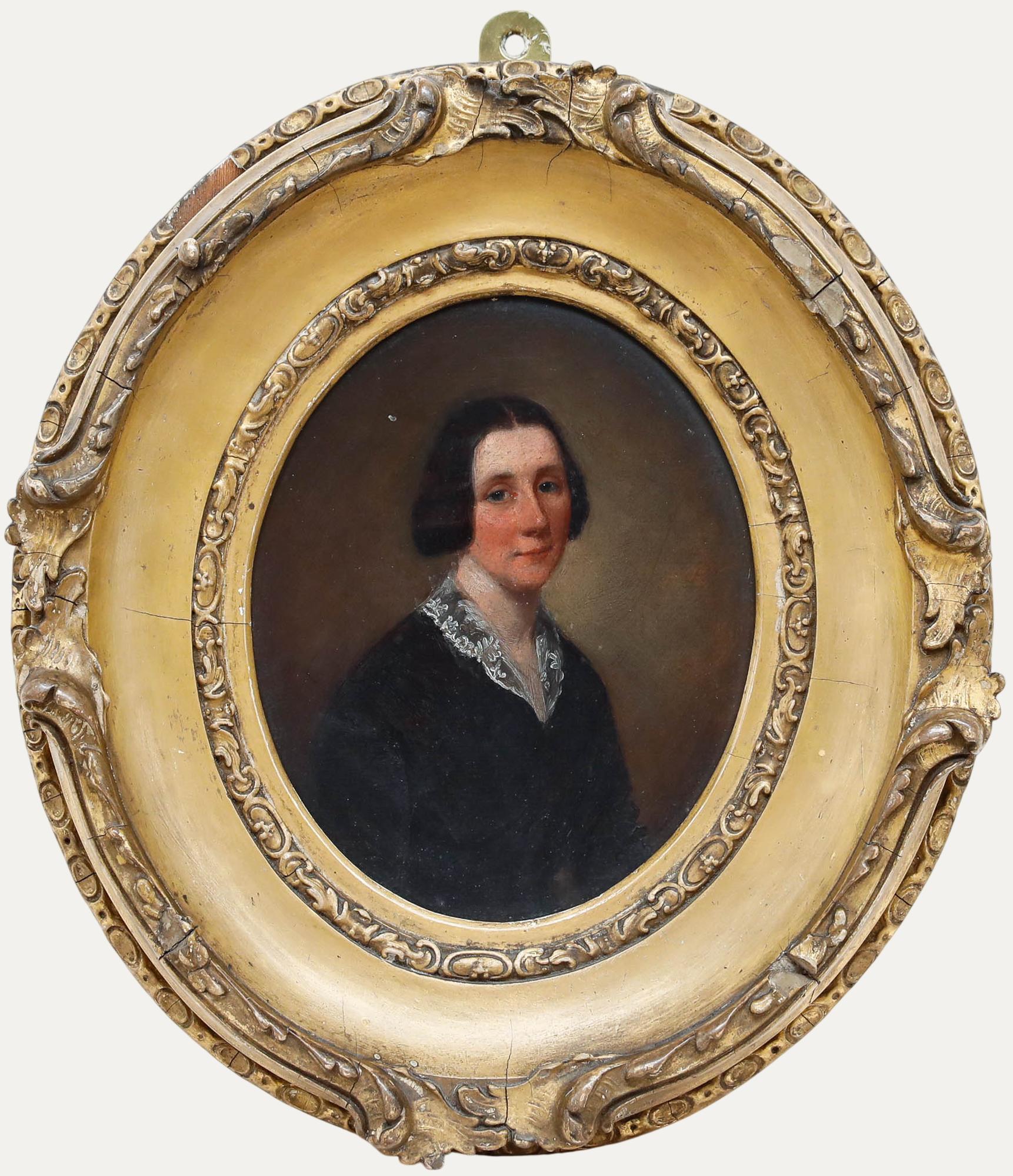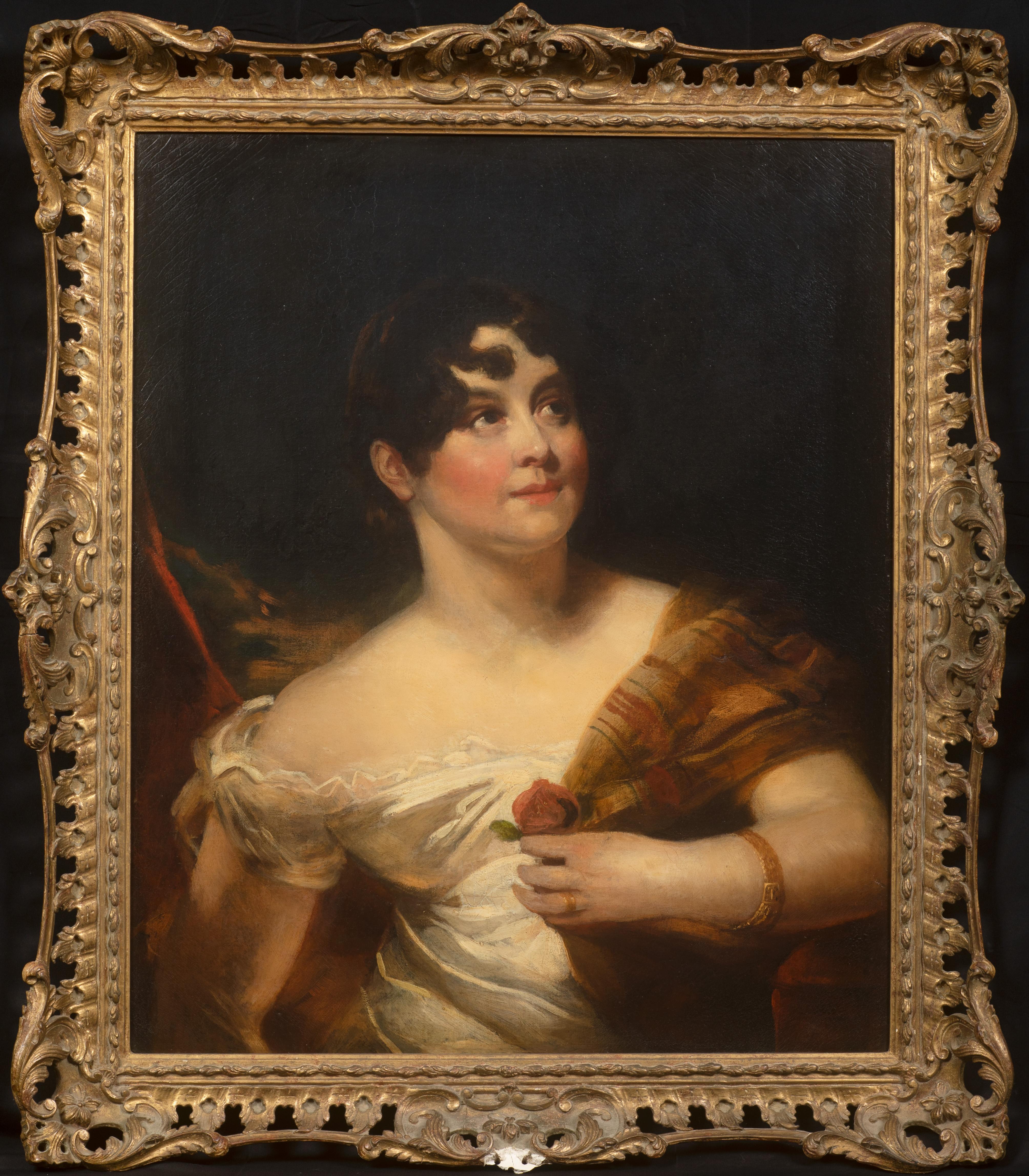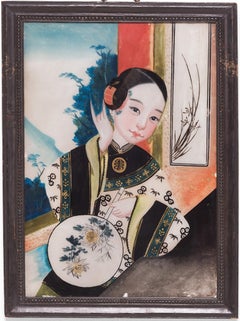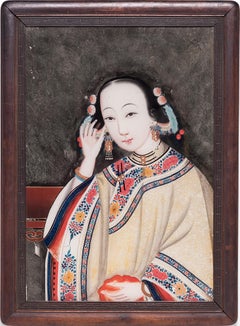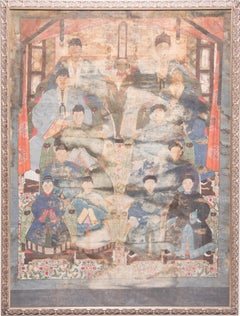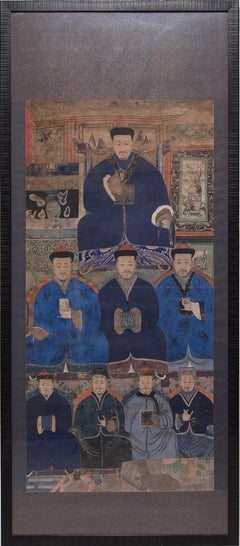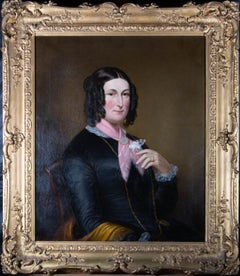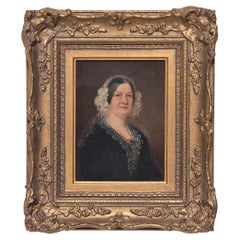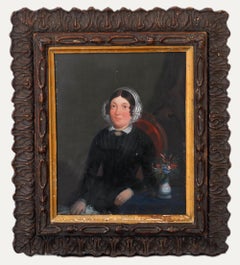Items Similar to Oil Portrait of a Victorian Lady, c. 1850
Want more images or videos?
Request additional images or videos from the seller
1 of 5
UnknownOil Portrait of a Victorian Lady, c. 1850c. 1850
c. 1850
$1,480
£1,124.10
€1,298.70
CA$2,074.27
A$2,321.50
CHF 1,211.65
MX$28,310.36
NOK 15,507.42
SEK 14,679.75
DKK 9,692.05
Shipping
Retrieving quote...The 1stDibs Promise:
Authenticity Guarantee,
Money-Back Guarantee,
24-Hour Cancellation
About the Item
Painted in the 19th century, this exquisite miniature portrait wonderfully exemplifies realism in traditional oil painting. The small artwork is painted in the conventional portraiture style of the Old Masters, and achieves soft realism with fine brushwork and a subdued, neutral palette. The half length portrait depicts a fine Victorian woman dressed in all black with a delicate lace collar and bonnet. She wears a ruby broach at her bust and a long gold chain. Captured with great depth and sensitivity, we can assume from her mourning dress and poignant expression that the subject is a noble woman and a widow. The painting is set in a beautiful giltwood frame decorated with floral scrollwork and darkened by a light patina.
From the collection of Frances and Gary Comer.
- Creation Year:c. 1850
- Dimensions:Height: 13.75 in (34.93 cm)Width: 11.5 in (29.21 cm)Depth: 1.75 in (4.45 cm)
- Medium:
- Movement & Style:
- Period:
- Condition:
- Gallery Location:Chicago, IL
- Reference Number:Seller: CFC2631stDibs: LU1036312778902
About the Seller
5.0
Vetted Professional Seller
Every seller passes strict standards for authenticity and reliability
1stDibs seller since 2018
30 sales on 1stDibs
- ShippingRetrieving quote...Shipping from: Chicago, IL
- Return Policy
Authenticity Guarantee
In the unlikely event there’s an issue with an item’s authenticity, contact us within 1 year for a full refund. DetailsMoney-Back Guarantee
If your item is not as described, is damaged in transit, or does not arrive, contact us within 7 days for a full refund. Details24-Hour Cancellation
You have a 24-hour grace period in which to reconsider your purchase, with no questions asked.Vetted Professional Sellers
Our world-class sellers must adhere to strict standards for service and quality, maintaining the integrity of our listings.Price-Match Guarantee
If you find that a seller listed the same item for a lower price elsewhere, we’ll match it.Trusted Global Delivery
Our best-in-class carrier network provides specialized shipping options worldwide, including custom delivery.More From This Seller
View AllChinese Reverse Glass Portrait of a Young Woman, c. 1900
Located in Chicago, IL
With exquisite detail and sparkling color, this portrait of a young woman is a remarkable example of reverse glass painting. Lending the finished work a subtle three-dimensional effe...
Category
Late 19th Century Qing Portrait Paintings
Materials
Glass, Paint
Chinese Reverse Glass Portrait of a Young Woman
Located in Chicago, IL
With exquisite detail and sparkling color, this portrait of a young woman is a remarkable example of reverse glass painting. Lending the finished work a subtle three-dimensional effe...
Category
Early 20th Century Qing Portrait Paintings
Materials
Glass, Paint
Monumental Chinese Ancestor Portrait, c. 1900
Located in Chicago, IL
Reflecting the role that ancestor worship played in Chinese culture, this Qing-dynasty painting depicts several generations of family, dressed in intrica...
Category
20th Century Qing Figurative Paintings
Materials
Linen, Wood, Paint, Pigment
Chinese Qing-Dynasty Ancestor Portrait
Located in Chicago, IL
This intricately detailed composition is a late-Qing dynasty ancestor portrait depicting several generations of a family's male ancestry. Or...
Category
Late 19th Century Qing Figurative Paintings
Materials
Fabric, Silk, Paint, Pigment
Chinese Mythical Immortal Screen Painting, c. 1850
Located in Chicago, IL
Since the 12th century, people in China have used folding screens and doors to partition and decorate their homes - the vivid scenes backing the screens added life and color to a roo...
Category
Mid-19th Century Figurative Paintings
Materials
Fabric, Ink, Pigment
Chinese Mythical Immortal Screen Painting, c. 1850
Located in Chicago, IL
Since the 12th century, people in China have used folding screens and doors to partition and decorate their homes - the vivid scenes backing the screens added life and color to a roo...
Category
Mid-19th Century Figurative Paintings
Materials
Fabric, Ink, Pigment
You May Also Like
Fine c.1845 Oil - Portrait of a Widow
Located in Corsham, GB
This very fine portrait of a middle-aged woman from the mid 19th Century is a true find. The unknown sitter looks directly out at the viewer with a subtle half-smile. She wears a simple black dress...
Category
19th Century Portrait Paintings
Materials
Oil
$4,367 Sale Price
20% Off
Oil Portrait of a Victorian Lady, c. 1850
Located in Chicago, IL
Painted in the 19th century, this exquisite miniature portrait wonderfully exemplifies realism in traditional oil painting. The small artwork is painted in the conventional portraiture style of the Old Masters, and achieves soft realism with fine brushwork and a subdued, neutral palette. The half length portrait depicts a fine Victorian woman dressed in all black with a delicate lace collar and bonnet. She wears a ruby broach...
Category
Antique Mid-19th Century British Victorian Decorative Art
Materials
Paint
Framed Late 19th Century Oil - A Distinguished Lady
Located in Corsham, GB
A fine 19th century Continental School portrait depicting a distinguished lady, set against a dark background with a floral arrangement adding colour and depth. The portrait is beaut...
Category
Late 19th Century Portrait Paintings
Materials
Oil
Mid-19th-Century German School, Portrait Of A Woman
Located in Cheltenham, GB
This fine mid-19th-century German miniature depicts a woman wearing a black dress and a beautiful white and lilac day cap.
Produced around 1840, this exquisite piece on porcelain is...
Category
1840s Victorian Portrait Paintings
Materials
Porcelain
Fine 19th Century Oil - Graceful Jane
Located in Corsham, GB
A wonderful 19th-century oil portrait of a graceful Victorian lady. The lady is pictured with a dainty lace collar and a neat hairstyle typical of the time. Signed illegibly in penci...
Category
19th Century Portrait Paintings
Materials
Oil
Portrait Of A Lady, 19th Century
By Sir Thomas Lawrence
Located in Blackwater, GB
Portrait Of A Lady, 19th Century
circle of Sir Thomas LAWRENCE (1769-1830)
Fine large early 19th Century portrait of a young lady, oil on canvas. Super quality and condition study ...
Category
19th Century Portrait Paintings
Materials
Canvas, Oil
More Ways To Browse
Antique Oil Portraits
Antique Oil Cans
Lace Collar
Mourning Art
Miniature Oil Portrait
Floral Old Masters
Victorian Oil Portrait Black
Collection Of Frances And Gary Comer
Antique Lace Collars
Oil Painting Of Victorian Lady
Victorian Gold Collar
Portrait Collar Dress
Portrait Mourning
Miniature Portrait Of A Lady
Victorian Mourning Art
Antique Lace Bonnet
Antique Victorian Bonnet
Antique Broach

